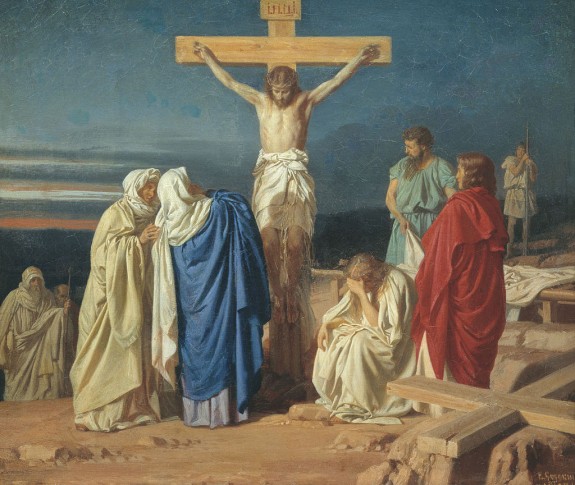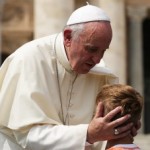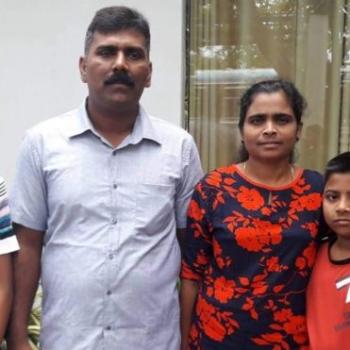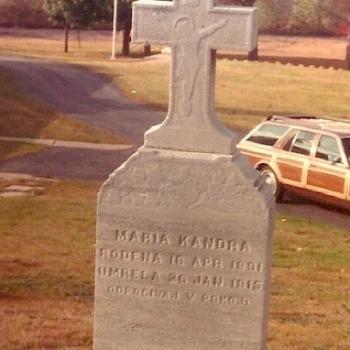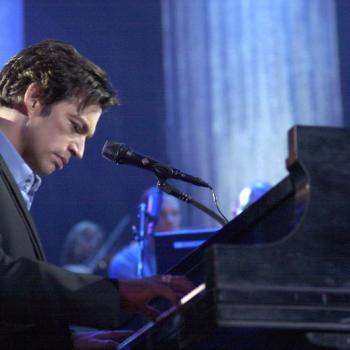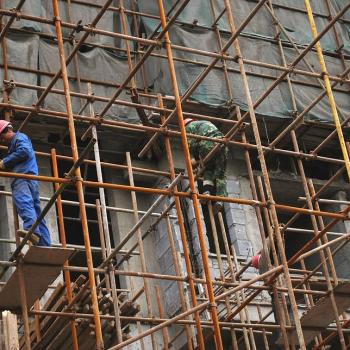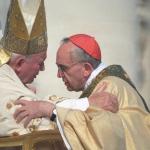My parish, Our Lady Queen of Martyrs, traditionally celebrates its feast day tomorrow, the feast of Our Lady of Sorrows. Fittingly, it follows today’s feast of the Exaltation of the Cross. From the vault, I found this homily from 2008, with some thoughts on those feasts.
+
This Sunday, marks the feast of the Exaltation of the Cross. And like we do at every Sunday mass, we began this celebration with a procession down the aisle, following that cross. It leads us to the altar, and to Christ.
That is what the cross is all about. But it’s such a universal symbol of our faith, and we see it so often, we almost take it for granted. We shouldn’t. It exists as a mysterious paradox: that instrument of death that gave us life. It brought our salvation.
And very often when you see the cross, you will see something else. You’ll notice it here, in the crucifix that is over our tabernacle: it is the woman standing beneath it. Mary. The woman whose own life is so closely entwined with that cross. And the woman we honor in a special way at this mass, as we celebrate our parish feast for Our Lady Queen of Martyrs.
The beautiful gospel we just heard tells us:
God so loved the world, that He gave us his only son.
But consider this: God so loved the world…that He also gave us Mary. I’d like us to think about that this afternoon – what she represents to us, to our faith, and to our parish.
The church calendar is full of feasts dedicated to Our Lady: The Immaculate Conception, or the Assumption, or Mary as Mother of God. But when you try to explain those concepts, or define them, it isn’t easy. Those holy days are abstract, hard to grasp.
But not this one.
This is one feast, the feast of Our Lady of Sorrows, that brings Mary directly into our own human experience. It reminds us that this most blessed of women is, first and foremost, a woman. She is one of us: a teenager, a wife, a widow, a mother. And she suffered the most painful heartbreak a mother can know: the death of her child.
We call her the Queen of Martyrs because she shared in Christ’s suffering. His martyrdom was hers, as she watched the one to whom she gave life…surrender his life.
One of the oldest hymns in the Church, dating from the 13th century, is the “Stabat Mater Dolorosa,” or “Stabat Mater.” Roughly translated, “the Sorrowful Mother was standing.”
At the cross her station keeping, stood the mournful mother weeping.
When we hear it during Lent, I’m always struck by the astounding strength in that image. Mary didn’t collapse. Or weaken. She stood. For hours. Just to be there, for her son.
And she is there, too, for us.
The woman who stood at the foot of the cross stands with all of us, in all the martyrdoms of life.
She stands with all of us who have felt frightened or persecuted…alone or anxious. Mary knows the feeling. And when it mattered most, she didn’t bend.
She stood.
From the cross, Jesus said, “Behold your mother.”
And this weekend, as we mark our parish feast, we do — with profound gratitude and love.
…This morning, I passed by the statue of Mary that we have out in the garden behind the church. People had placed flowers there, as they often do. And I noticed some scraps of paper. I went for a closer look. They were notes to the Blessed Mother. One on top was weathered and faded and smudged. I don’t know how long it has been there. It said simply: “Please, Virgin Mary, help me.”
That’s just one message among many. Think of all the prayers that have been offered, all the petitions brought to Our Lady in this church. All the candles that have been lit, the masses that have been celebrated, the rosaries that have been prayed.
And think, too, of the history this place has witnessed.
In this church, mothers came to pray to Mary to protect their sons who scaled the cliffs at Normandy. In these pews, families have prayed for peace in places like Saigon and Beirut and Baghdad.
Here is where we gathered in grief and fear the day the towers fell.
In this sacred space, we have come to pray over all the hurts in the human heart. The job that was lost. The house that was foreclosed. The biopsy results. The argument that drove two people apart.
Within these walls, we have come for assurance, hope, grace. Here, too, is where new life has begun. Weddings, first communions, confirmations, baptisms. The boundless hope that has been affirmed within these walls! But a parish is more than geography, more than a building. It is community. And, it is where this community marks the most important moments of our lives.
If you look over by the baptismal font, there is a window dedicated to a man who preached often about Mary, St. Bernard of Clairvaux. He was the one who added this brief phrase to the Memorare: “O Clement, O Loving, O Sweet Virgin Mary.” And it’s fitting that he watches over the place of baptism, because he taught how to live a life dedicated to Mary, with her as our model.
He once offered a beautiful meditation about the Blessed Mother — words that could echo in the heart of everyone who has been blessed at that font, and in the hearts of all of us who seek solace and strength from the Queen of Martyrs.
“While she holds your hand,” St. Bernard wrote, “you cannot fall; under her protection you have nothing to fear; if she walks before you, you shall not grow weary; if she shows you favor, you shall reach the goal.”
As we mark this feast, and celebrate our parish anniversary, let us make those words our own to the “clement, loving, sweet Virgin Mary.”
Because, as we’ve been reminded, God so loved the world that He gave us His only son.
And what a blessing: He loved us so much, He also gave us Mary.
Image:”Crucifixion” by Evgraf Semenovich Sorokin / Wikipedia

